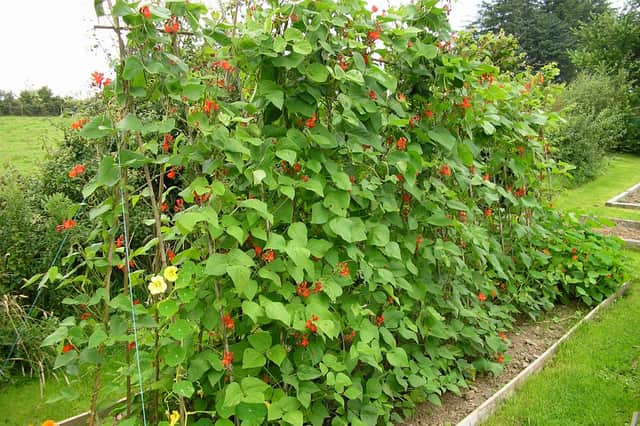Gardening: How to avoid problems with runner beans | Brian Kidd


Even if you live in a flat, they are super when grown in a growing bag so plants can romp up walls.
This week we’re looking at things that can go wrong. I hope you don't have these problems but if you do, you’ll learn how to solve them.
Advertisement
Hide AdAdvertisement
Hide AdThe first problem came from a new allotment holder at Fareham. Leaves were sent in on which only the veins were left intact. The problem? Slugs and snails.
There had been no sign of these pests during the day but after recent rain on just one night, the whole row was shredded. The slugs had come through the allotment fence from long grass growing in the area of land just outside the site.
To prevent this happening again, it would be a good idea to dust the area below the fence with Copper Mixture. You’ll find this in a green plastic container and is normally dissolved in water to correct copper deficiency but slugs can’t crawl over the area treated because the copper melts the slime on their bodies.
The alternatives are crushed egg shells or vermiculite. Slugs can't slide over vermiculite granules.
• Missed last week’s column? Here it is
Advertisement
Hide AdAdvertisement
Hide AdI sometimes get letters from gardeners who suddenly have a complete failure. Runner bean seeds germinate well but as the plants start to climb, they die off. This is because the bean seeds have been saved year after year from the same stock. It’s even worse if beans are always grown in the same place.
It’s good practice to buy new seeds every three years. I never save my own seeds because we eat all the beans so none is left to produce seeds!
Germination is the next problem – the beans don’t come up. The reasons are numerous: Too dry? Old seed? Crows or pigeons? The answer is to pre-chit the seeds before planting. Take a lunch box, put in a sheet of wet, absorbent kitchen paper, pour the seeds in and close the box. Keep it in the dark and look daily to see if a little root has appeared. Keep the paper moist.
Once roots are visible, put each seed into inset cells with universal compost and plant the seedlings out when they are four inches high. If roots don’t appear, the seeds are not viable. Don’t blame me if they don’t grow – the seeds were no good.
Advertisement
Hide AdAdvertisement
Hide AdFlowers fall off and no beans? Early-morning sparrows. The answer? Make a cat lying down out of cardboard, paint it black with a white patch on the front and put marbles where the eyes should be. Put this on the ground half way along the line of beans and move it every day. Don’t hang it, birds know cats can’t fly.
Loads of leaves but no flowers? Too much manure. The solution won’t be popular but does work. Remove half the leaves and put them on the compost. Fork over the soil and scatter on half an ounce of sulphate of potash to a yard run – no more – and water it in. An alternative is to cut the plants down to half their height (they will quickly grow again) and then add the potash. That’ll do the trick.
In August you may notice the lower leaves on the bean vines are show signs of light browning all over and there may be cobwebs along the veins on the back of leaves. This is a nasty pest called red spider mite and needs to be treated by spraying the backs of the leaves with Pyrethrum insecticide twice a week when the sun is off the leaves.
Finally, Freda from Emsworth wrote to tell me that bees were eating the rounded part of her runner bean flowers and reducing the crop by a third. What is going on here?
Advertisement
Hide AdAdvertisement
Hide AdThey are not honey bees but solitary bees using the bean flowers to line their nests. Luckily, this action only lasts for about three or four weeks in June.
Wild bees have now lined their nests, the eggs have hatched and the babies and mums are back to normal feeding on nectar and pollen.
Glad to say Freda asked for my advice and simply left them alone. Well done Freda.
THIS WEEK'S TOP TIP
If you’d like something beautifully rare, look out for Sternbergia bulbs. These are difficult to find. They love a sunny top with a shaded root. The 5in-high yellow crocus-like flowers appear in autumn and are smashing.